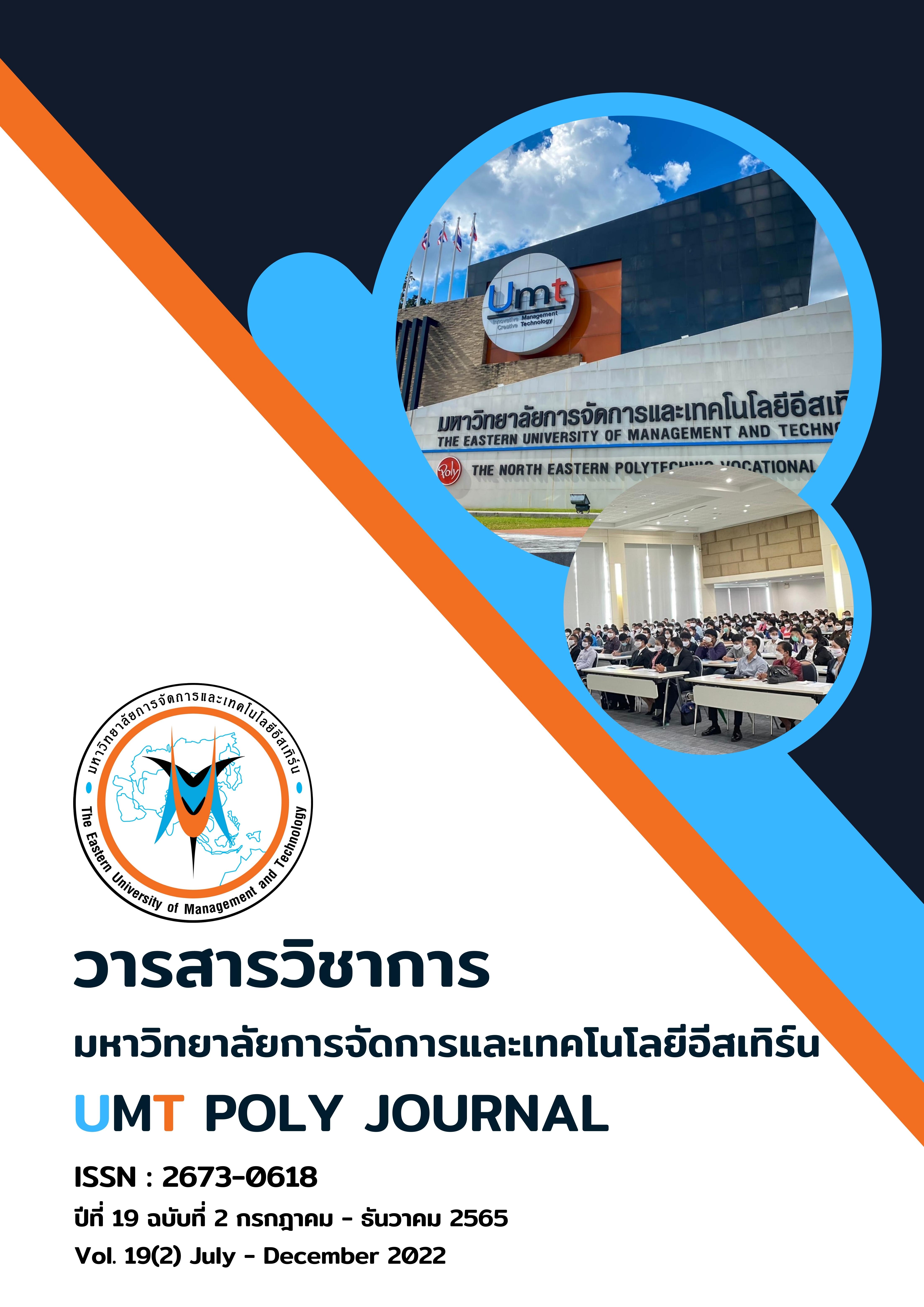The Influencing of Facebook Service Quality on Customer’s Satisfaction and Sustainable Usage Intention
Keywords:
Facebook Service Quality, Customer’s Satisfaction, Sustainable Usage IntentionAbstract
Abstract
The objective of this research is to study the influencing of Facebook service quality on customer’s satisfaction and sustainable usage intention. The researcher developed a questionnaire from literature review and collected 399 respondents of the people who have experiences in Facebook usage, in Srisaket province. The statistical analysis are percentage, frequency, standard deviation and multi-regression analysis. The research results revealed that the elements of Facebook service quality such as interaction quality and outcomes quality influenced and predicted significantly on customer’s satisfaction at 58%. It also influencing and predicted significantly on customer’s sustainable usage intention at 62%.
Downloads
References
รายการอ้างอิง
กัญญ์สิริ จันทร์เจริญ. (2554). บทที่ 5 การกำหนดประชากรและกลุ่มตัวอย่าง, https://www.ict.up.ac.th/surinthips/ResearchMethodology_2554....PDF
ประสพชัย พสุนนท์. (2557). ความเชื่อมั่นของแบบสอบถามในงานวิจัยเชิงปริมาณ, วารสารปาริชาต มหาวิทยาลัยทักษิณ, 27(1), 144-163.
พงษ์ศักดิ์ ซิมมอนด์ส. (2560). การทดสอบข้อตกลงเบื้องต้นของการวิเคราะห์การถดถอยเชิงเส้นตรง, วารสารวิจัยและพัฒนาหลักสูตร, 7(2), 20-37.
วีระศักดิ์ จินารัตน์. (2564). ระเบียบวิธีวิจัยสมัยใหม่, พิมพ์ครั้งที่ 1; อุบลราชธานี, ยงสวัสดิ์ อินเตอร์กรุ๊ปจำกัด.
วีระศักดิ์ จินารัตน์. (2564). มาตรฐานงานวิจัยเชิงปริมาณและการพัฒนา, พิมพ์ครั้งที่ 1; อุบลราชธานี, ยงสวัสดิ์ อินเตอร์กรุ๊ปจำกัด.
Bano, S., Cisheng. W., Khan. A. N., & Khan. N. A. (2019). WhatsApp use and student's
psychological well-being: Role of social capital and social integration. Children and Youth Services Review, vol. 103, pp. 200-208.
Brady, MK, & Cronin. J. (2001). Some new thoughts on conceptualizing perceived
service quality. A hierarchicalapproach, 65, 34-49.
Chotipunyo, W., & Wongpinunwatana, N. (2015). Factors affecting positive attitude and purchase intention towards transgender products via facebook social network website: case study www.facebook.com/toodsdiary, JISB, 1(1), 73-85.
Chen, S.C, Yen. D.C, & Hwang. M.I. (2012). Factors influencing the continuance intention
to the usage of Web 2.0. An empirical study. Comput. Hum. Behav, 28, 933-941.
Duong, G. H, Wu. W.-Y, & Le. L. H. (2020). The effects of brand page characteristics on
customer brand engagement: Moderating roles of community involvement and comedy production contents. Journal of Brand Management, 27, 1-15.
Ebrahim. R. S. (2019). The role of trust in understanding the impact of social media
marketing on brand equity and brand loyalty. Journal ofRelationship Marketing, 19(4), 1-22.
Ellison, N.B., Steinfield. C. & Lampe. C. (2007). The Benefits of Facebook "Friends":
Social Capital and College Students' Use of Online Knowledge Sharing Among Tourists via Social Media Social Network Sites. J. Comput Med. Commun, 12, 1143-1168.
Gronroos, C.A. (1984). Service quality model and its marketing implications, 18, 36-44.
Hsu, W.S, Qing, F., Wang. C.C, & Hsieh. L.H. (2018). Evaluation of service quality in
facebook-based group-buying. Electronic Commerce Research and Application, 28, 30-36.
Hossain, M. A., & Kim. M. (2020). A comprehensive study on social commerce in social
networking sites. Sage Open, pp. 1-13.
Hossain, A. & Kim. M. (2018). Does Multidimensional Service Quality Generate
Sustainable Use Intention for Facebook. Sustainability 2018, 10, 2283; doi: 10.3390/su10072283.
Hennig, T.T, Gwinner. K.P, Walsh. G, & Gremler. D.D. (2004). Electronic word-of-mouth
via consumer-opinion platforms. What motivates consumers to articulate themselves on the Internet, 18, 38-52.
Kuo, Y.F, Wu. C.M, & Deng. W.J. (2009). The relationships among service quality,
customer satisfaction, and post-purchase intention in mobile value-added services. Comput. Hum. Behav, 25, 887-896.
Lu, Y, Zhang. L, & Wang. B. (2009). A multidimensional and hierarchical model of
mobile service quality. Electron. Commer. Res. Appl, 8, 228-240.
Lien, C. H., Cao. Y., & Zhou. X. (2017). Service quality, satisfaction, stickiness and usage
intentions: An exploratory evaluation in the context of WeChat services", Computers in Human Behaviour, vol. 68, pp. 403-410.
Raza, S.A., Qazi. W., & Umer. A. (2016). Facebook is a source of social capital building
among university students: Evidence from a developing country. Journal of Educational Computing Research, pp. 1-28.
Vivek, SD. (2009). A Scale of Consumer Engagement. Ph.D. Thesis, The University of
Alabama, Tuscaloosa AL USA.
Wang, W, Hsieh. JP, & Song. B. (2012). Understanding user satisfaction with instant
messaging: An empirical study. Int. J. Hum. Comput. Int, 28, 153-162.
Wiese, M, Martínez-Climent. C, & Botella-Carrubi. D. (2020). A frame work for
Facebook advertising effectiveness: A behavioral perspective Journal of Business Research, 109, 76-87.
Wang, K.-Y, Chih. W.-H, & Hsu. L.-C. (2020). Building Brand Community relationships on
Facebook Fan pages: The role of perceived interactiv-ity. International Journal of Electronic Commerce, 24(2), 211-231.
Zhao, L, Lu. Y, Zhang. L, & Chau. PYK. (2012). Assessing the effects of service quality
and justice on customer satisfaction and the continuance intention of mobile value-added services: An empirical test of a multidimensional model. Decis. Support Syst, 52, 645-656.
Downloads
Published
Issue
Section
License
ประกาศลิขสิทธิ์
เนื้อหาและข้อมูลในบทความที่ลงตีพิมพ์ในวารสารวิชาการมหาวิทยาลัยการจัดการและเทคโนโลยีอีสเทิร์น ถือเป็นข้อคิดเห็นและความรับผิดชอบของผู้เขียนบทความโดยตรง ซึ่งกองบรรณาธิการวารสารไม่จำเป็นต้องเห็นด้วยหรือร่วมรับผิดชอบใด ๆ
บทความ ข้อมูล เนื้อหาหรือรูปภาพ ฯลฯ ที่ได้รับการตีพิมพ์ในวารสารวิชาการมหาวิทยาลัยการจัดการและเทคโนโลยีอีสเทิร์น ถือเป็นลิขสิทธิ์ของวารสารวิชาการมหาวิทยาลัยการจัดการและเทคโนโลยีอีสเทิร์น หากบุคคลหรือหน่วยงานใดต้องการนำข้อมูลทั้งหมดหรือบางส่วนไปเผยแพร่ต่อหรือเพื่อกระทำการใด ๆ จะต้องได้รับอนุญาตเป็นลายลักษณ์อักษรจากวารสารวิชาการมหาวิทยาลัยการจัดการและเทคโนโลยีอีสเทิร์นก่อนเท่านั้น




